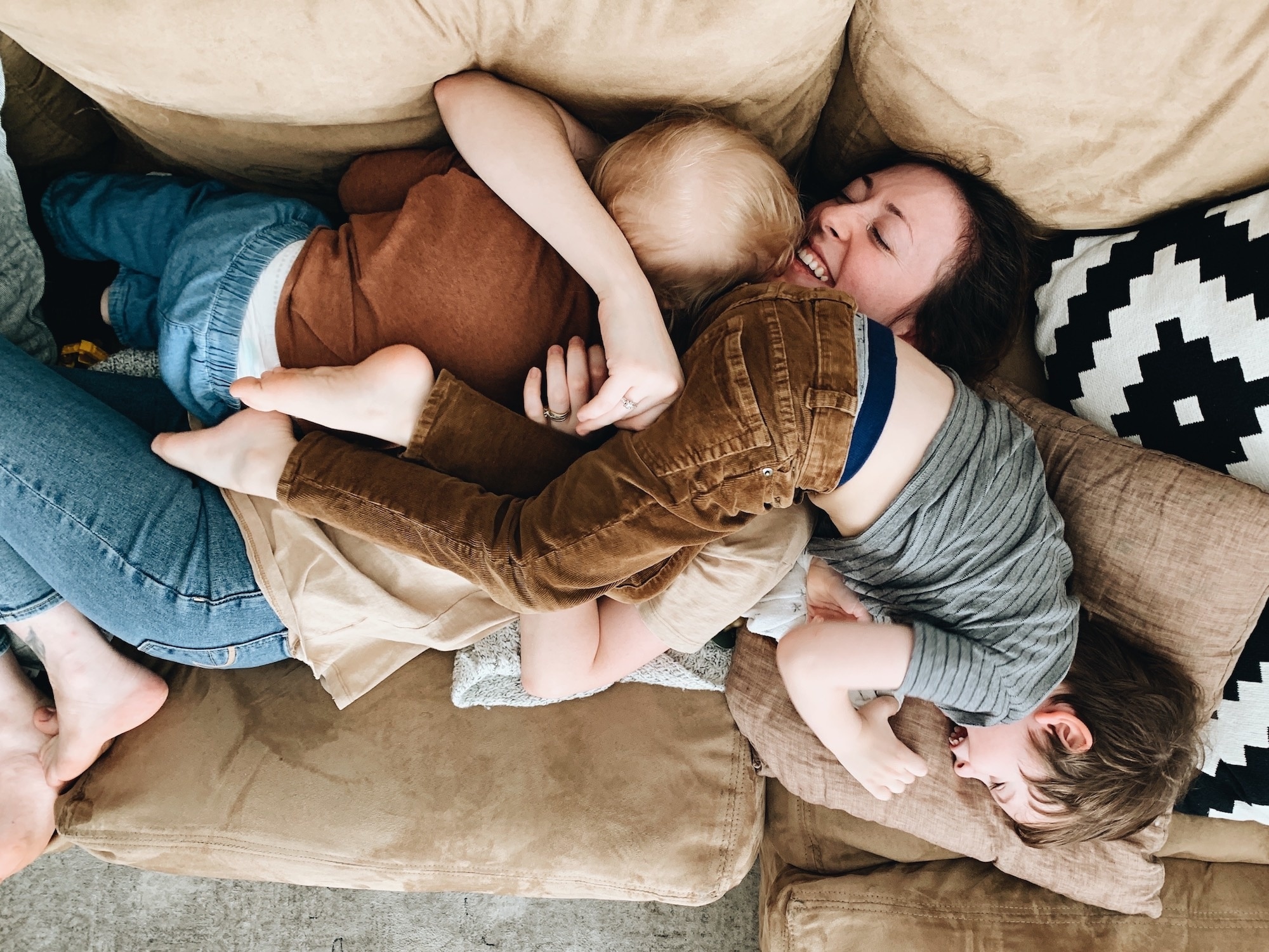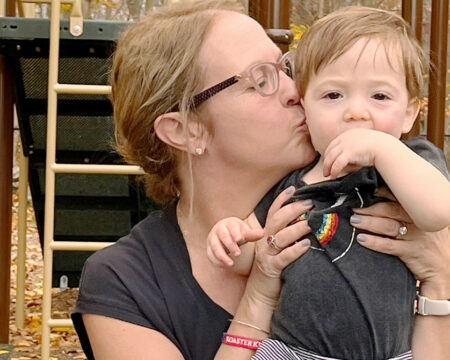How to set loving limits that actually work
Science shows that kids need healthy boundaries to thrive—here's how to set limits in a loving, effective way.

Setting boundaries with kids can feel like one of the trickiest parts of gentle parenting. We worry that if we’re too harsh, we’re going down the slippery slope of authoritarian parenting (if authoritarian parenting had a tagline, it would be “my way or the highway”). We don’t want to do that. On the flip side, if we’re too permissive in our parenting boundaries, we know that doesn’t bode well for our children, either. Setting boundaries with kids can feel a bit like walking on an emotional tightrope.
We all understand the importance of healthy boundaries with kids, but what should those boundaries look like? How do we hold our kids accountable without damaging them? Finally, what does it look like if our child doesn’t seem to be respecting the boundary that we’ve set?
How can we create healthy, loving boundaries with kids?
Let’s start with the benefits of healthy boundaries with kids.
When we set and follow through on healthy boundaries with kids, it helps them with their executive functioning skills. Further, it encourages emotional regulation. It helps them develop problem-solving skills, and they can also feel more connected to us because they know what we expect of them. All of those things are correlated with higher self-esteem and better long-term outcomes in their personal, academic, and professional lives.
In short, every part of a child’s development is enhanced by having a healthy relationship with boundaries—both the ones they set for themselves, and the ones we create for their physical and emotional well-being.
The importance of being proactive
Part of setting healthy boundaries is being proactive. Children simply often don’t know what’s expected of them. Relatively speaking, life on Earth is still new to them (and with so much to learn in a short amount of time, it’s no wonder they have trouble remembering all the “rules” sometimes). They simply don’t have the life experience we do to know what’s so-called “normal” behavior.
Tell them upfront what to expect before they encounter new situations. Then lovingly reinforce the boundary as many times as you need to, because to a young child, it’s a lot to process! The more you practice setting healthy boundaries with kids when they’re young, the easier it is for them to self-regulate when they get older—and the less retroactive parenting you’ll need to do.
When you set boundaries for young children, think “big picture.” What’s the most important takeaway you want your child to know? Focus on that and let the rest go, lest they go into information overload and lose the core message you want to convey.
The younger the child, the more clearly you’ll need to paint a mental picture for them about what you expect. Further, setting boundaries for young children works best if the child hears expectations as close to the event as possible. The exception is if you plan to role play the boundary with them. Building in extra time to practice can be very helpful.
Here’s a specific example of what helping a child learn a boundary might look like.
“On Friday, we’re going to a restaurant. At restaurants, food needs to stay on your plate, even if you don’t want it. Rather than putting it on the floor or directly on the tablecloth, what might you do with it?” Consider their ideas. If need be, you might suggest, “We can put a separate empty plate on the table. If there’s something you don’t want, you can simply move the food to that empty plate. We can call it the ‘no thank you’ plate.” Then, in the days preceding the event, “play” restaurant at home so your child can practice.
It’s also important to have age-appropriate expectations for your child. Just because you’ve told a 3-year-old that they need to use silverware at a restaurant doesn’t mean they’ll use it as you intend it—especially if they’re not accustomed to using it at home.
For an older child, parental boundaries can come closer to whatever activity your child is doing. Let’s say the topic is screen time. If you set boundaries only after you realize your child has pulled an all-nighter on the iPad, restricting screen time the next day may feel like to them like punishment. Naturally, both the child and the adult want to avoid feeling like they’ve received, or inflicted, that response. Better would be to have a mutually agreed upon “check-in time” beforehand, wherein the child returns the iPad to a centralized location by whatever time you’ve chosen.
Proactively setting boundaries with kids helps them mentally prepare and visualize themselves succeeding with the boundary. It reduces their guesswork.
Of course, some boundaries naturally come about after we—the adults—realize that something isn’t working for our family. That’s okay, too. What matters is the approach you take in discussing it with your child.
The importance of getting buy-in on boundaries with kids
Help kids succeed when you set healthy boundaries by letting them have a say in the details. Their buy-in is directly related to the amount of input they feel they’ve had in the process.
Does that mean they set the boundary? No, they don’t set it. You do. However, they absolutely can (and should) have input about how it plays out in their lives.
The words you choose in your approach matter greatly. Think about how you’d react if your partner or someone else you respect said, “I’ve made a bunch of rules you need to follow.” I’d hazard a guess to say, at the very least, you’d raise an eyebrow.
Better would be to present a problem statement and approach it as a collaborative problem-solving process. Once you’ve addressed the problem statement, you can turn it into a family agreement rather than a “rule.” Feels different, doesn’t it?
Here’s an example of what this looks like in practice:
I’ve noticed a lot of shoes near the front door and I’m concerned they’re a tripping hazard.” [problem statement] “I wonder how we can keep the house safe AND you can get to playing as quickly as possible. Let’s brainstorm.”
Now, your child might offer, “Yeah! You can put away my shoes for me!” While that’s one option, not every parent would be on board with that solution. If you are, great—there’s really no drawback to modeling graciousness.
Alternatively, you might say, “I could do that. I also want it to feel fair to everyone. What could we try that would be fair?” Perhaps one of you suggests a shoe rack closer to the door, or some other solution that’s mutually acceptable.
That said, it’s important to accept some of your child’s ideas so they build trust in the collaborative process. That reinforces to them that you’re on the same team. You’ll be surprised how often kids—even very young ones—are truly excellent problem solvers.
Model having an open mind, and you’ll both benefit from it.
The importance of being realistic—and specific—in boundaries with kids
How might specific and realistic boundaries in parenting look? I’ll share an example from my own home.
My child loves pillows. She loves sliding off the couch on them, pretending they’re lily pads and jumping on them, building forts with them, whatever. I can live with pillow play.
What I’m not comfortable with is cleaning up the pillows that have “migrated” from room to room throughout the day, every day. So, I knew I had to set boundaries around that.
Here’s what didn’t work: “Everyone needs to put away everything they’ve used throughout the day.”
Why wouldn’t that work? Several reasons, but for one, it’s far too broad. It’s overwhelming. Plus, I’d be a hypocrite — even I don’t put away everything I’ve moved throughout the day. I need to play fairly.
What worked better: “I see how much you enjoy playing with the pillows!” (This validates my child’s feelings about them and supports her fun.) “I feel overwhelmed when I keep having to put things back where they go, so pillows need to stay in their original rooms. You can play with them all you want, but living room couch pillows stay in the living room, bedroom pillows stay in the bedroom.”
In taking this approach, my child knows she still gets to play. And I don’t spend the day wondering why every room in the house looks like it blew into the room adjacent to it.
The importance of supporting your kids when they have big feelings about non-negotiable boundaries
Oftentimes, when a child has big feelings about boundaries, it’s either because they feel they didn’t have enough of a vote or if they didn’t truly understand why the boundary was important.
Repeated struggles over boundaries are often a result of a child simply not feeling that their emotional experience has been heard. Once we demonstrate to them, “Hey, I get what you’re going through and I understand your motivation,” it helps them feel seen and valued. From there, more cooperation happens naturally.
Along with that, make sure you’ve explained why the boundary exists—without over-explaining (you want to avoid sounding preachy and diluting your message). Whenever possible, explain the “why” from the child’s point of view. I’ll share three examples of setting boundaries with kids since this is often a particularly sticky area for loving caregivers:
Setting boundaries with kids, example 1: Your child wants a toy at the store and your answer is no. What wouldn’t work is this: “I’m worried about money and I don’t want to buy you that toy.” A child will probably not share that perspective. Alternative: “I see how much you want that toy. Let’s go home and I’ll check the budget, and we’ll see if there’s a way to get it sometime. Let’s take a picture of it now so we remember to put it on your wish list.” Your boundary is still clear—you’re not buying the toy today—but it’s more palatable this way.
Setting boundaries with kids, example 2: Your child wants to run into the street. That’s a hard no. Alternative: You make sure to proactively create plenty of free-range running at a local park or somewhere else that’s void of moving vehicles. When your child makes a beeline for the street, you remind them of where they can run. Then follow through at your next opportunity.
Setting boundaries with kids, example 3: Your child is insisting on dessert for dinner. You want to maintain your boundary of not skipping the dinner you cooked for the sweets. Alternative: You let your child plan the meals for the week alongside you so they feel like they’ve had a say; and you consciously build in whatever amount of sweets works for your family.
In all three of these examples, the child will feel “seen”—and with problem solving at the core, their executive functioning skills can grow accordingly. The ultimate goal of boundaries with kids is to create win/win situations.
If they feel they didn’t have enough of a vote but it’s non-negotiable, do your best to hold space for their feelings without getting defensive. Trust that if they’re opening up to you about their displeasure, they’re still opening up to you — and you want to reinforce that you’re a safe place to do that.
Co-regulate with your child and trust that like all storms, this too shall pass. If your child is open to physical touch, that can be helpful in calming their nervous system. Do what works for your child, allowing them to fully express how they feel.
The sense of confidence and calm that you exude will help them find their peace again. Let your tone, your words, and your heart be gentle with them.
The point of boundaries with kids is to foster healthy relationships with everyone’s physical and emotional safety at the center.
Remember that boundaries with kids are not brick walls. Actively listen to your child and remember you’re raising a child, not following a rule book for so-called proper living. Your job is to figure out what works for everyone in your home, and how you can live together peacefully.
When you’re an emotionally safe place for your child, they’ll learn that even when all of their behaviors might not be acceptable, all of their feelings are. The empathy you show your child while you’re navigating boundaries together will connect you both. Your relationship will be stronger for working alongside them.
Originally published on the author’s blog.


